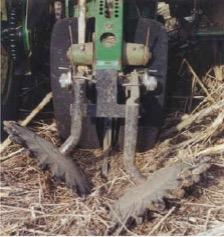By Ethan Begle
Exapta is celebrating 25 years in the business of improving planters and drills for no-till seeding. We are very thankful for all of you who have purchased from us over these 25 years. We hope to have made seeding more successful on your operation. With a goal of writing a 50th anniversary newsletter, we plan to continue looking for ways to make no-till planting easier and more successful. This newsletter will focus on the past and what brought us to this benchmark.
The word Exapta comes from the word Exaptation, which means a shift in the function of an object from its original natural design. Exapta produces parts that enhance existing planters and drills designed for tillage systems. We are adapting the designed function to work in no-till systems.
As I’m sure most of our readers know our founder, Matt Hagny started the company as an extension of his crop consulting business. After evaluating poor crop emergence and flawed design from the no-till planters at the time, Matt was focused on improving stands for his clients. Lots of observation and working with the ideas of farmers at the time propelled him to bring his ideas to fruition.
1999-2009 HCS
The Hagny Closing System was Matt’s first improvement for planters and drills. Closing was a big issue in no-till conditions and spike closing wheels had not become popular yet. By giving the wheels a 50° camber, they closed the furrow by slicing and crumbling the sidewall, not squeezing, thus avoiding sidewall compaction. The HCS system lays the spoked wheel over and moves it closer to the furrow, so that the spokes slice cleanly through the sidewall and carry or push the fragmented soil into the furrow. The idea made sense on paper and worked well in the field in a few conditions, but residue flow became an issue because of the angle of the wheels. Once the Thompson Wheel and toe-out wedge came into being, angling the wheels 6° on the OEM closing brackets, farmers were satisfied with the closing without having to change the bracket.
In 2002 the Thompson Wheel was developed in partnership with area farmers, Keith & Ben Thompson around a favorable wheel of that time (May-Wes star-pictured above). There were complaints with bearing life and mud buildup on closing wheels, which is why the Thompson Wheel uses an oversized bearing still today, so as to provide guaranteed (five year) wear-life, to avoid breakdowns in the field. High-strength steel and a squared, spoke design, that limits depth, are the advantages that separate the Thompson wheel from others.
2006- Mojo Wire
Exapta has long been a proponent of using a seed firmer to firm the seeds into the furrow. Many farmers were already running Keetons on their planters. However, after digging through the furrows, farmers were finding too many seeds were not actually being firmed into the bottom. A closer look revealed the firmers, after a few hundred acres of use, lost their tension and were no longer staying in the furrow well enough to push the seeds down. Using spring steel, the Mojo Wire was added to the Keeton in order to keep it stiff—and in the furrow—with more down pressure. An additional benefit to the added pressure is it kept the Keeton clean from mud buildup on the tails. Keeping the Keeton firmly in the furrow, where mud can’t cling to the tail, continues to be a big issue and the Mojo Wire has solved this issue in most soils. With excellent results, the Keeton + Mojo combination still is the best attachment to be added to the planter to achieve even emergence.
2012- Valion
Seed tube guards hadn’t been given much thought as a wear item. No-till conditions accelerated wear and it became clear that furrows were not staying wide enough for the seeds—or a Keeton—to reach the bottom of the furrow properly. Staying on top of planter maintenance became of critical importance with no-till planting conditions. Since farmers were having trouble getting through one season before the guard was too narrow, Exapta initially recommended using RK seed tube guards for much longer wear life vs OEM. Exapta then introduced the Valion seed tube guard for increased wear life, with the option for putting liquid in-furrow ahead of and below the seed. With guards to fit JD and Kinze planters they have proven to last much longer than OEM even today.
2015- Ninja
The Ninja flap was our first foray into drills and air seeders. The existing JD flaps were flat and brittle. They would break easily, and the shape didn’t even fit in the furrow correctly. The Ninja solved these problems, with flexible material and a V-shape to match the furrow. With a 20° bend the Ninja flap completely covers the end of the seed boot so there is not a gap at the soil line. Other flaps on the market are too long and stiff, trying to apply pressure to the seed. Exapta’s view is simply for a flap to keep the seed in the furrow so the firming wheel behind it can push the seed into furrow.
The importance of the seed flap keeping the seed in the furrow, pointed to another issue: of OEM and aftermarket firming wheels being too wide to fit the furrow properly. Exapta had recommended the Case IH SDX firming wheel as the best on the market, at the time, due mainly to its narrow shape that fit in the furrow. The SDX wheel had pressed bearings, and the tire would want to pull out of the rim. Oddly enough, Case scrapped that firming wheel on the new P-500 series of air drills. Exapta introduced the DuraLok firming wheel, which stacked on all the advantages of the SDX wheel with an easily replaceable bearing hub, flexible poly tire, and narrow design to fit in the furrow correctly.
UniForce came along after years of evaluation and testing. Plus, with hydraulic downforce on planters already being proven, it was time to replace the spring on the JD single disc drill openers. Because of the radial arm design, where the openers pivot from one point, the down pressure is not always being applied at the same angle compared to a parallel link. This makes the actual working range of the spring very small. UniForce was designed to be simple: if a grower is wanting an automated system, it’s better spent on a planter where seed accuracy is greater. With UniForce, all the cylinders are tied together to move oil between openers as they go through the field terrain, making the whole drill run very smoothly. This adds up to much greater consistency of depth for the seeds.
We have seen and heard from our customers about their successes from these products over the years. We will continue to improve existing products and evaluate performance in the field. Look for new products from us in the future as we continue to find better ways to make seeding successful in no-till farming.

